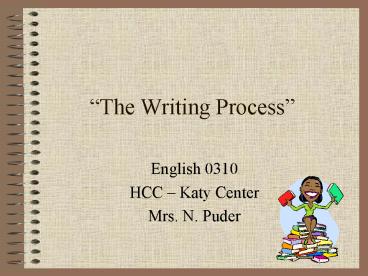The Writing Process - PowerPoint PPT Presentation
1 / 17
Title:
The Writing Process
Description:
Who Am I Writing To? Tone. What Kind of Impression Should My Writing Give. ... To Amuse. Identify Your Audience. Your Audience Is. An Academic Audience ... – PowerPoint PPT presentation
Number of Views:56
Avg rating:3.0/5.0
Title: The Writing Process
1
The Writing Process
- English 0310
- HCC Katy Center
- Mrs. N. Puder
2
Analyze Your Assignment
- Formatting
- Heading
- Title
- Spacing
- Margin Layout
- The Little Brown Handbook, 687-688.
- Language
- Informal
- Formal
- Length
- One Paragraph
- Two-Three Pages
3
Analyzing Your Assignment
- Time Restraints
- In-Class or Out
- Sources
- Library
- Interviewing
- Purpose
- What Is My Reason For Writing?
- Audience
- Who Am I Writing To?
- Tone
- What Kind of Impression Should My Writing Give.
4
Determine Your PurposeSome Purposes Are
- To Express Feelings and Attitudes
- To Persuade
- To Give Pleasure
- To Convey Information
- To Inform
- To Discover
- To Analyze
- To Debate
- To Criticize
- To Define
- To Compare or Contrast
- To Narrate/Describe
- To Amuse
5
Identify Your Audience
6
Your Audience Is An Academic Audience
- An Academic Audience Expects
- Correct Information
- Standard Grammar and Spelling
- Logical Presentation of Ideas
- Stylistic Fluency (Word Choice and Sentence
Structure) - Define Terms and Support Generalizations with
Specifics - Express Thoughts Clearly and Accurately
7
Tone(Attitude Adopted As You Write)
- Personal Conversational
- Serious
- Respectful
- Formal
- Angry
- Humorous
- Sentimental
- Nostalgic
8
Five Stages of the Writing Process
- Prewriting
- Planning
- Writing
- Revising
- Editing
9
Stage 1 Prewriting Find a Subject Gather
Information
- Focused Free writing
- The Little Brown Handbook , 20-21
- 5-15 Minutes of Concentrated, Nonstop Writing
about Your Topic. - Then, Review What You Have Written.
- Listing or Brainstorming
- A Way of Listing Information About Your Topic.
- The Little Brown Handbook , 21
10
Prewriting Continued
- Clustering
- The Little Brown Handbook, 22-23
- Keeping a Journal
- The Little Brown Handbook, 17 -18
- Observing Your Surroundings
- The Little Brown Handbook, 19-
- Reading
- The Little Brown Handbook, 17 -18
11
Prewriting Strategies Continued
- Asking Journalistic Questions
- (5Ws and H) (Who, What, Why, Where, When, and How
- The Little Brown Handbook, 23-24
12
Stage 2 Planning Focus on a Main Idea Map
Out an Approach
- Thesis Statement.
- The Central Point The Essay Supports.
- More Than a Title, a Statement of Fact, or an
Announcement - Carefully Worded and Accurately Predicts Your
Essays Direction, Emphasis, and Scope.
13
Planning Continued
- Tree Diagram
- The Little Brown Handbook, 35.
- Outlying
- Formal
- Informal
- The Little Brown Handbook, 35-38.
14
Stage 3 Writing
- Draft Your Essay
- Skip Intro If It Is a Problem And Return To It
Later - Start Where You Think Your Writing Is Going To Be
Productive - Stop To Reread As You Go Or Continue If The
Writing Seems To Flow Well
15
Stage 4 Revising
- Re-See What You Have Written
- Look For Major Improvements In
- Content
- Enlarging or narrowing the thesis.
- Adding more examples or cutting irrelevant ones.
16
Organization
- Organization
- Reorganizing Points
- Changing Paragraph Order
- For More Tips See the Yellow Information Box
The Little Brown Handbook, 49 and 51.
17
Stage 5 Editing
- Check Grammar
- Word Choice
- Spelling
- Punctuation
- Mechanics
- The Little Brown Handbook, 58-59































